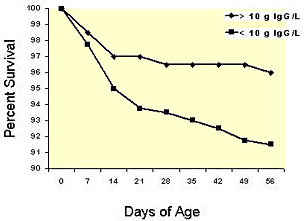



The Importance of Colostrum for Calves
Colostrum intake is critical for a newborn calf, as its immune system is not fully developed when born, says Nanita Blomquist, Alberta Ag-Info Centre, Alberta Agriculture and Rural Development.
The calf must rely on colostrum from its mother until its own immune system is developed at 1 to 2 months of age. Colostrum contains antibodies or immunoglobulins (essential proteins) necessary to provide the calf with protection from disease. This immunity that the calf receives is known as passive immunity.
How much colostrum does a calf need?
Generally a calf should receive 5 to 6 per cent of its body weight as colostrum within the first six hours of life, and another 5 to 6 per cent of its body weight when the calf is 12 hours old. Colostrum weighs about 8 lbs per (US) gallon or 10 pounds (Imperial gallon), therefore an 80 lb calf would require 4 lbs of colostrums per feeding.

Why is the time in which a newborn receives colostrum so important?
By the 24-hour mark the gut begins to close and it becomes extremely difficult for the calf to absorb the antibodies in the colostrum. The calf’s intestine becomes impermeable to large proteins. Studies have shown, that at six hours after birth, calves absorbed 66 per cent of the immunoglobulins in colostrum, but at 36 hours after birth calves were able to absorb only 7 per cent of immunoglobulins. Colostrum contains approximately 22 per cent solids, compared to 12 per cent solids in normal whole cow's milk. Much of the extra solid material in colostrum is immunoglobulin, but colostrum is also an important source of protein, sugar, fat, and vitamins A and E.

Can I give newborns commercial colostrum supplements?
Calves that have experienced prolonged calving, tend to take longer to stand and nurse, may need to be tube fed colostrum or colostrum supplements. These supplements are typically less efficient (the calf will not receive the same amount of protein) but are effective enough when colostrum is not available. Typically the commercial supplements are derived from a processed bovine serum, and have been shown to absorb much more efficiently.
Can I store colostrum?
Colostrum can be collected, froze, and used at a later date. Colostrum should be collected from cows within 24 hours of calving. For easier handling and storage, use Ziploc® bags or Serving Savers®. The bags or containers will store flat in the freezer and you can use a size, which makes thawing individual "servings" of colostrum easier (1 or 2 quarts). Colostrum should not be thawed and refrozen. Colostrum can be stored frozen for up to a year with no loss of quality. Also storing at a moderate temperature (~ 20° C) for 2 days or refrigeration for 1 week should not result in a decrease in quality.
What is the proper way to thaw colostrum?
Correct thawing is important to prevent the colostrum from being damaged. Colostrum should be thawed slowly in warm water. A good practice to follow is to submerge the sealed, frozen container in a bath of warm (not hot) tap-water until it thaws completely, stirring occasionally. Thawing time will vary depending on container size. The colostrum should be warmed to 40°C to 43°C. Colostrum can be thawed in a microwave oven, at a low setting, and should be stirred frequently, as many microwaves do not heat evenly. Thawing in warm water is recommended over using the microwave.
Should I get colostrum from a dairy or other neighboring herds?
It is best to have colostrum on hand from your own herd if possible, as using colostrum from dairy’s or other herds raises biosecurity issues and differences in immunoglobulin concentration. It is important to know the operation and their practices well before using their colostrum.
How much colostrum will a cow produce?
Cows begin to produce colostrum five weeks prepartum and ends at calving. The antibodies are transferred from the bloodstream. Typically, mature beef cows in good condition will produce an antibody mass in approximately ½ gallon of colostrum. It is important to ensure during the week prior to calving that the cow is not “leaking” milk or being nursed by other calves, otherwise colostrum will be deficient when the cow calves.
What factors affect colostrum quality and quantity?
Age of the Dam – The amount of colostrum and the amount of antibody concentration are lower in first and second calvers than in older cows. There is continued antigenic stimulation with age. Older cows also have larger udders, better milk secretion capability and a more efficient antibody transport mechanism. Maintaining heifers in separately from older cow is prudent for both nutritional needs and colostral management.
Breed and Milking Volume - Large colostral volumes tend to have lower antibody concentrations. Dairy cattle tend to have lower antibody concentrations than beef cattle.
Nutrition – Protein levels are important for volume, quality and maintaining antibody content. A good nutrition program will increase the immunoglobulin concentration in the colostrum. Discuss with your nutritionist to ensure your cows are receiving appropriate vitamins and minerals.
January 2009


